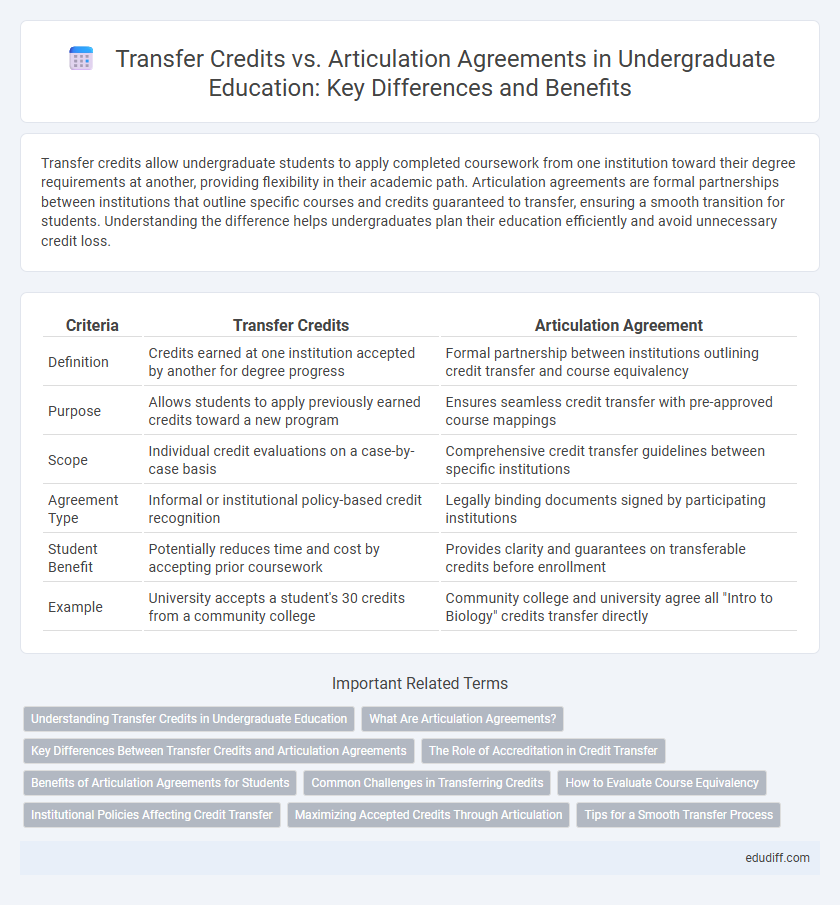Transfer credits allow undergraduate students to apply completed coursework from one institution toward their degree requirements at another, providing flexibility in their academic path. Articulation agreements are formal partnerships between institutions that outline specific courses and credits guaranteed to transfer, ensuring a smooth transition for students. Understanding the difference helps undergraduates plan their education efficiently and avoid unnecessary credit loss.
Table of Comparison
| Criteria | Transfer Credits | Articulation Agreement |
|---|---|---|
| Definition | Credits earned at one institution accepted by another for degree progress | Formal partnership between institutions outlining credit transfer and course equivalency |
| Purpose | Allows students to apply previously earned credits toward a new program | Ensures seamless credit transfer with pre-approved course mappings |
| Scope | Individual credit evaluations on a case-by-case basis | Comprehensive credit transfer guidelines between specific institutions |
| Agreement Type | Informal or institutional policy-based credit recognition | Legally binding documents signed by participating institutions |
| Student Benefit | Potentially reduces time and cost by accepting prior coursework | Provides clarity and guarantees on transferable credits before enrollment |
| Example | University accepts a student's 30 credits from a community college | Community college and university agree all "Intro to Biology" credits transfer directly |
Understanding Transfer Credits in Undergraduate Education
Transfer credits in undergraduate education enable students to apply previously earned course credits from one accredited institution toward the completion of their degree at another school, reducing redundancy and accelerating graduation timelines. These credits are evaluated for equivalency based on course content, accreditation status, and grade requirements, ensuring alignment with the receiving institution's curriculum standards. Understanding the transfer credit process is essential for students aiming to optimize their academic pathways and minimize credit loss during transitions between colleges.
What Are Articulation Agreements?
Articulation agreements are formal partnerships between two or more educational institutions that outline the transfer policies for specific courses or programs, ensuring seamless credit acceptance. These agreements standardize curriculum alignment and guarantee that credits earned at one institution will be recognized by the partner institution, facilitating a smoother transition for undergraduate students. Unlike general transfer credits, articulation agreements provide predefined pathways and clarity on degree requirements, helping students avoid credit loss or duplication.
Key Differences Between Transfer Credits and Articulation Agreements
Transfer credits allow students to apply previously earned college credits toward a new degree, subject to institutional evaluation and acceptance policies. Articulation agreements are formal partnerships between institutions that predefine the transferability of specific courses or credits, ensuring a smoother transition. The key difference lies in transfer credits being evaluated on a case-by-case basis, while articulation agreements provide guaranteed credit recognition based on established agreements.
The Role of Accreditation in Credit Transfer
Accreditation plays a crucial role in the transfer of undergraduate credits by ensuring that the courses completed meet recognized academic standards, which allows institutions to evaluate the legitimacy and equivalency of transfer credits. Transfer credits are more readily accepted when earned from accredited institutions with compatible curricula, reducing the risk of losing credit during the transfer process. Articulation agreements formalize this process by establishing predefined pathways between accredited colleges, streamlining credit transfer and guaranteeing that students receive proper credit for completed coursework.
Benefits of Articulation Agreements for Students
Articulation agreements provide clear pathways for students to transfer credits seamlessly between institutions, ensuring course compatibility and reducing credit loss. These agreements enhance academic planning by outlining guaranteed transfer policies, which minimize course repetition and maximize credit applicability toward degree completion. Students benefit from accelerated degree timelines, lower tuition costs, and smoother transitions by leveraging structured transfer agreements rather than navigating uncoordinated credit transfer processes.
Common Challenges in Transferring Credits
Transfer credits often face challenges due to differences in course content, grading standards, and accreditation between institutions, complicating the evaluation process. Articulation agreements help streamline credit transfers by predefining equivalencies, yet students may still encounter limitations with elective credits or program-specific requirements. Ensuring accurate transcript evaluation and maintaining consistent academic standards remain critical hurdles in maximizing transfer credit acceptance for undergraduates.
How to Evaluate Course Equivalency
Evaluating course equivalency requires a detailed comparison of syllabi, learning outcomes, and credit hours between the transfer credits and the receiving institution's curriculum. Analyzing course content alignment and accreditation standards ensures that the transfer credits meet academic requirements. Utilizing articulation agreements as references can streamline the evaluation process by providing pre-approved equivalency guidelines between partnering institutions.
Institutional Policies Affecting Credit Transfer
Institutional policies governing transfer credits often determine the acceptance of coursework from other universities based on factors such as accreditation, course equivalency, and grade requirements. Articulation agreements formalize these policies by providing pre-approved pathways that simplify credit transfer between specific institutions, ensuring seamless progression toward degree completion. Variations in credit evaluation policies and residency requirements significantly impact how effectively transfer credits contribute to an undergraduate academic program.
Maximizing Accepted Credits Through Articulation
Articulation agreements provide a structured framework between institutions to guarantee the acceptance of specific transfer credits, maximizing the credits undergraduate students can apply toward their degree. These formal agreements outline pre-approved courses and equivalencies, reducing the risk of credit loss compared to general transfer credit evaluations. Utilizing articulation agreements strategically ensures a smoother transition and more efficient progression through undergraduate programs.
Tips for a Smooth Transfer Process
When managing transfer credits during an undergraduate program, prioritizing thorough research of articulation agreements between institutions ensures course equivalency and credit acceptance. Maintaining organized academic records and obtaining official transcripts promptly facilitates accurate credit evaluation and smooth enrollment. Communicating proactively with academic advisors and registrars mitigates delays and supports seamless credit transfer.
Transfer Credits vs Articulation Agreement Infographic

 edudiff.com
edudiff.com